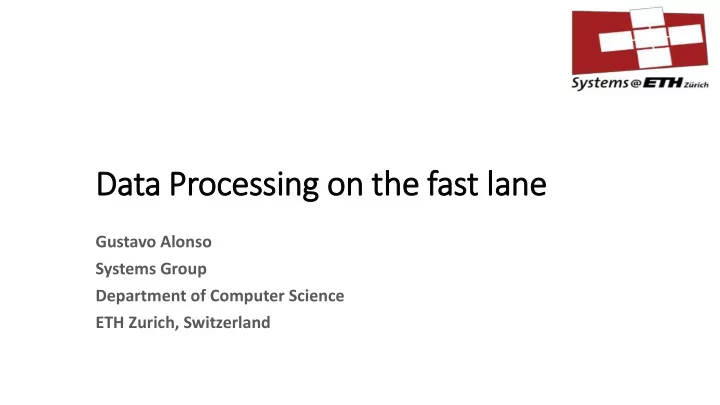

Data Processing on the fast la lane Gustavo Alonso Systems Group Department of Computer Science ETH Zurich, Switzerland
The team behind the work: • Rene Müller (now at IBM Almaden) • Louis Woods (now at Apcera) • Jens Teubner (now Professor at TU Dortmund) David Sidler Muhsen Owaida Zsolt Istvan Kaan Kara
Data processing today: Appliances Data Centers (Cloud)
What is a database engine? • As complex or more complex than an operating system • Full software stack including • Parsers, Compilers, Optimizers • Own resource management (memory, storage, network) • Plugins for application logic • Infrastructure for distribution, replication, notifications, recovery • Extract, Transform, and Load infrastructure • Large legacy, backward compatibility, standards • Hugely optimized
Databases are blindly fast at what they do well
Databases = think big ORACLE EXADATA From Oracle documentation
Database engine trends: Appliances Oracle: T7, SQL in Hardware, RAPID SAP: OLTP+OLAP on main memory SAP Hana on SGI UV 300H Hana on SGI supercomputer SGI documentation Nobody ever got fired for using Hadoop on a Cluster A. Rowstron, D. Narayanan, A. Donnely , G. O’Shea, A. Douglas HotCDP 2012, Bern, Switzerland
SQL on FPGAs Presentation at HotChips’16 from Baidu http://www.nextplatform.com/2016/08/24/baidu-takes-fpga-approach-accelerating-big-sql/
The challenge of hardware acceleration
If it sounds too good to be true ..
Usual unspoken caveats in HW acceleration • Where is the data to start with? • Where does the data has to be at the end? • What happens with irregular workloads? • What happens with large intermediate states? • What is the architecture? • Is the design preventing the system from doing something else? • Can the accelerator be multithreaded? • Is the gain big enough to justify the additional complexity? • Can the gains be characterized?
Do not replace, enhance Help the CPU to do what it does not do well
Text search in databases FCCM’16 INTEL HARP: This is an experimental system provided by Intel any results presented are generated using pre- production hardware and software, and may not reflect the performance of production or future systems.
100% processing on FPGA
Hybrid Processing CPU/FPGA
Accelerators to come From Oracle M7 documentation
If the data moves, do it efficiently Bumps in the wire(s)
(Woods, VLDB’14) IBEX
A processor on the data path
Storage to come • Recent example BISCUIT from Samsung (ISCA’16) • User programmable Near-Data Processing for SSDs From Samsung presentation at ISCA’16 http://isca2016.eecs.umich.edu/wp-content/uploads/2016/07/3A-1.pdf
Sounds good? The goal is to be able to do this at all levels: Smart storage On the network switch (SDN like) On the network card (smart NIC) On the PCI express bus On the memory bus (active memory) Every element in the system (a node, a computer rack, a cluster) will be a processing component
Disaggregated data center Near Data Computation
Consensus in a Box (Istvan et al, NSD’16) Xilinx VC709 Evaluation Board FPGA SW Clients / SFP+ TCP Reads Other nodes Replicated Other nodes Writes SFP+ Direct Networking key-value store Atomic Broadcast Other nodes SFP+ Direct SFP+ DRAM (8GB) 01-Sep-16 23
The system 3 FPGA cluster 10Gbps Switch Comm. over TCP/IP Comm. over direct + Leader election connections X 12 + Recovery Clients • Drop-in replacement for memcached with Zookeeper’s replication • Standard tools for benchmarking (libmemcached) • Simulating 100s of clients 24
Latency of puts in a KVS Direct connections ~3 μ s Consensus Memaslap (ixgbe) 15-35 μ s ~10 μ s TCP / 10Gbps Ethernet 25
The benefit of specialization… 10000000 Specialized Througput (consensus rounds/s) solutions 1000000 10-100x FPGA (Direct) FPGA (TCP) 100000 DARE* (Infiniband) General Libpaxos (TCP) purpose Etcd (TCP) 10000 solutions Zookeeper (TCP) 1000 1 10 100 1000 Consensus latency (us) [1] Dragojevic et al. FaRM: Fast Remote Memory . In NSDI’14. 26 [2] Poke et al. DARE: High-Performance State Machine Replication on RDMA Networks. In HPDC’15. *=We extrapolated from the 5 node setup for a 3 node setup.
This is the end … Most exciting time to be in research Many opportunities at all levels and in all areas FPGAs great tools to: Explore parallelism Explore new architectures Explore Software Defined X/Y/Z Prototype accelerators
FPGAs: the view from an outsider
Difficulty to program • FPGAs are no more difficult to program than system software (OS, databases, infrastructure, etc.) • Only a handful of programmers can do system software, my guess is system programmers are not many more than the people who can program FPGAs • But FPGAs have no tools to enhance productivity, specially no freely available tools (GCC, instrumentation, libraries, open source tools …)
CS vs EE • EE = understand parallelism • CS= understand abstraction You need both (and these days a lot more: systems, algorithms, machine learning, data center architecture, …)
Complete systems • The proof of something that makes a difference is an end to end argument • Showing that something is faster when running on an FPGA does not mean it will be faster when hooked into a real system (example: GPUs)
Recommend
More recommend